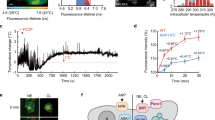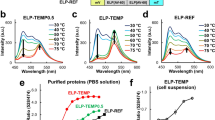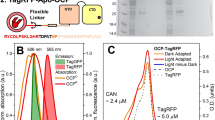Abstract
In mammals and birds, thermoregulation to conserve body temperature is vital to life. Multiple mechanisms of thermogeneration have been proposed, localized in different subcellular organelles. However, visualizing thermogenesis directly in intact organelles has been challenging. Here we have developed genetically encoded, GFP-based thermosensors (tsGFPs) that enable visualization of thermogenesis in discrete organelles in living cells. In tsGFPs, a tandem formation of coiled-coil structures of the Salmonella thermosensing protein TlpA transmits conformational changes to GFP to convert temperature changes into visible and quantifiable fluorescence changes. Specific targeting of tsGFPs enables visualization of thermogenesis in the mitochondria of brown adipocytes and the endoplasmic reticulum of myotubes. In HeLa cells, tsGFP targeted to mitochondria reveals heterogeneity in thermogenesis that correlates with the electrochemical gradient. Thus, tsGFPs are powerful tools to noninvasively assess thermogenesis in living cells.
This is a preview of subscription content, access via your institution
Access options
Subscribe to this journal
Receive 12 print issues and online access
$259.00 per year
only $21.58 per issue
Buy this article
- Purchase on Springer Link
- Instant access to full article PDF
Prices may be subject to local taxes which are calculated during checkout






Similar content being viewed by others
Accession codes
References
Nicholls, D.G. & Locke, R.M. Thermogenic mechanisms in brown fat. Physiol. Rev. 64, 1–64 (1984).
Block, B.A. Thermogenesis in muscle. Annu. Rev. Physiol. 56, 535–577 (1994).
Silva, J.E. Thermogenic mechanisms and their hormonal regulation. Physiol. Rev. 86, 435–464 (2006).
Enerbäck, S. et al. Mice lacking mitochondrial uncoupling protein are cold-sensitive but not obese. Nature 387, 90–94 (1997).
Matthias, A. et al. Thermogenic responses in brown fat cells are fully UCP1-dependent. J. Biol. Chem. 275, 25073–25081 (2000).
Cannon, B. & Nedergaard, J. Brown adipose tissue: function and physiological significance. Physiol. Rev. 84, 277–359 (2004).
de Meis, L. Uncoupled ATPase activity and heat production by the sarcoplasmic reticulum Ca2+-ATPase. Regulation by ATP. J. Biol. Chem. 276, 25078–25087 (2001).
Meis, L., Arruda, A.P. & Carvalho, D.P. Role of sarco/endoplasmic reticulum Ca2+-ATPase in thermogenesis. Biosci. Rep. 25, 181–190 (2005).
Paulik, M.A. et al. Development of infrared imaging to measure thermogenesis in cell culture: thermogenic effects of uncoupling protein-2 troglitazone, and β-adrenoceptor agonists. Pharm. Res. 15, 944–949 (1998).
Schröder, H.J. & Power, G.G. Engine and radiator: fetal and placental interactions for heat dissipation. Exp. Physiol. 82, 403–414 (1997).
Suzuki, M., Tseeb, V., Oyama, K. & Ishiwata, S. Microscopic detection of thermogenesis in a single HeLa cells. Biophys. J. 92, L46–L48 (2007).
Gota, C., Okabe, K., Funatsu, T., Harada, Y. & Uchiyama, S. Hydrophilic fluorescent nanogel thermometer for intracellular thermometry. J. Am. Chem. Soc. 131, 2766–2767 (2009).
Yang, J.-M., Yang, H. & Lin, L. Quantum dot nano thermometers reveal heterogeneous local thermogenesis in living cells. ACS Nano 5, 5067–5071 (2011).
Oyama, K. et al. Walking nanothermometers: spatiotemporal temperature measurement of transported acidic organelles in single living cells. Lab Chip 12, 1591–1593 (2012).
Okabe, K. et al. Intracellular temperature mapping with a fluorescent polymeric thermometer and fluorescence lifetime imaging microscopy. Nat. Commun. 3, 705 (2012).
Kucsko, G. et al. Nanometre-scale thermometry in a living cell. Nature 500, 54–58 (2013).
Tsien, R.Y. The green fluorescent protein. Annu. Rev. Biochem. 67, 509–544 (1998).
Chudakov, D.M., Lukyanov, S. & Lukyanov, K.A. Fluorescent proteins as a toolkit for in vivo imaging. Trends Biotechnol. 23, 605–613 (2005).
Hurme, R., Berndt, K.D., Normark, S.J. & Rhen, M. A proteinaceous gene regulatory thermometer in Salmonella. Cell 90, 55–64 (1997).
Naik, R.R., Kirkpatrick, S.M. & Stone, M.O. The thermostability of an α-helical coiled-coil protein and its potential use in sensor applications. Biosens. Bioelectron. 16, 1051–1057 (2001).
De Angelis, D.A., Miesenböck, G., Zemelman, B.V. & Rothman, J.E. PRIM: proximity imaging of green fluorescent protein-tagged polypeptides. Proc. Natl. Acad. Sci. USA 95, 12312–12316 (1998).
VanEngelenburg, S.B. & Palmer, A.E. Fluorescent biosensors of protein function. Curr. Opin. Chem. Biol. 12, 60–65 (2008).
Terada, H. The interaction of highly active uncouplers with mitochondria. Biochim. Biophys. Acta 639, 225–242 (1981).
Ahmad-Junan, S.A., Amos, P.C., Cockerill, G.S., Levett, P.C. & Whiting, D.A. Synthetic studies on electron transport inhibitors related to natural products. Biochem. Soc. Trans. 22, 237–241 (1994).
Smiley, S.T. et al. Intracellular heterogeneity in mitochondrial membrane potentials revealed by a J-aggregate-forming lipophilic cation JC-1. Proc. Natl. Acad. Sci. USA 88, 3671–3675 (1991).
Imamura, H. et al. Visualization of ATP levels inside single living cells with fluorescence resonance energy transfer-based genetically encoded indicators. Proc. Natl. Acad. Sci. USA 106, 15651–15656 (2009).
Cannon, B. & Nedergaard, J. Nonshivering thermogenesis and its adequate measurement in metabolic studies. J. Exp. Biol. 214, 242–253 (2011).
Arruda, A.P. et al. Cold tolerance in hypothyroid rabbits: role of skeletal muscle mitochondria and sarcoplasmic reticulum Ca2+ ATPase isoform 1 heat production. Endocrinology 149, 6262–6271 (2008).
Lupas, A. Coiled coils: new structures and new functions. Trends Biochem. Sci. 21, 375–382 (1996).
Patterson, G.H., Knobel, S.M., Sharif, W.D., Kain, S.R. & Piston, D.W. Use of the green fluorescent protein and its mutants in quantitative fluorescence microscopy. Biophys. J. 73, 2782–2790 (1997).
Azzu, V. & Brand, M.D. The on-off switches of the mitochondrial uncoupling proteins. Trends Biochem. Sci. 35, 298–307 (2010).
Mall, S. et al. The presence of sarcolipin results in increased heat production by Ca2+-ATPase. J. Biol. Chem. 281, 36597–36602 (2006).
Bal, N.C. et al. Sarcolipin is a newly identified regulator of muscle-based thermogenesis in mammals. Nat. Med. 18, 1575–1579 (2012).
Collins, T.J., Berridge, M.J., Lipp, P. & Bootman, M.D. Mitochondria are morphologically and functionally heterogenous with in cells. EMBO J. 21, 1616–1627 (2002).
Kuznetsov, A.V. & Margreiter, R. Heterogeneity of mitochondria and mitochondrial function within cells as another level of mitochondrial complexity. Int. J. Mol. Sci. 10, 1911–1929 (2009).
Voets, T., Talavera, K., Owsianik, G. & Nilius, B. Sensing with TRP channels. Nat. Chem. Biol. 1, 85–92 (2005).
Montell, C. & Caterina, M.J. Thermoregulation: channels that are cool to the core. Curr. Biol. 17, R885–R887 (2007).
Haneda, T., Okada, N., Nakazawa, N., Kawakami, T. & Danbara, H. Complete DNA sequence and comparative analysis of the 50-kilobase virulence plasmid of Salmonella enterica serovar choleraesuis. Infect. Immun. 69, 2612–2620 (2001).
Dayel, M.J., Hom, E.F.Y. & Verkman, A.S. Diffusion of green fluorescent protein in the aqueous-phase lumen of endoplasmic reticulum. Biophys. J. 76, 2843–2851 (1999).
Wang, Y. & Weiner, H. The presequence of rat liver aldehyde dehydrogenase requires the presence of an α-helix at its N-terminal region which is stabilized by the helix at its C temini. J. Biol. Chem. 268, 4759–4765 (1993).
Schneider, J.P., Lear, J.D. & DeGrado, W.F. A designed buried salt bridge in a heterodimeric coiled-coil. J. Am. Chem. Soc. 119, 5742–5743 (1997).
Omatsu-Kanbe, M. & Matsuura, H. Inhibition of store-operated Ca2+ entry by extracellular ATP in rat brown adipocytes. J. Physiol. (Lond.) 521, 601–615 (1999).
Luo, J. et al. A protocol for rapid generation of recombinant adenoviruses using the AdEasy system. Nat. Protoc. 2, 1236–1247 (2007).
Grassi, F., Fucile, S. & Eusebi, F. Ca2+ signaling pathways activated by acetylcholine in mouse C2C12 myotubes. Pflugers Arch. 428, 340–345 (1994).
Acknowledgements
We thank N. Okada (Kitasato University) for virulence plasmid from Salmonella enterica. Technical support was provided by S. Yano, Y. Suzuki and T. Sakoguchi (Kyoto University). This work was supported by grants from the Ministry of Education, Culture, Sports, Science and Technology in Japan (to S.K. and Y.M.).
Author information
Authors and Affiliations
Contributions
S.K., T.M. and Y.M. initiated and designed the project. S.K., T.K., R.S. and D.S. performed experiments and analyzed data. M.O.-K. and H.M. supervised brown adipocyte studies. H.I. supervised ATP sensor studies. T.Y., I.H. and T.M. contributed to analysis and interpretation of data. S.K., R.S. and Y.M. wrote the manuscript. Y.M. directed the research. All authors discussed and commented on the manuscript.
Corresponding author
Ethics declarations
Competing interests
The authors declare no competing financial interests.
Supplementary information
Supplementary Text and Figures
Supplementary Figures 1–11 and Supplementary Tables 1 and 2 (PDF 3202 kb)
Rights and permissions
About this article
Cite this article
Kiyonaka, S., Kajimoto, T., Sakaguchi, R. et al. Genetically encoded fluorescent thermosensors visualize subcellular thermoregulation in living cells. Nat Methods 10, 1232–1238 (2013). https://doi.org/10.1038/nmeth.2690
Received:
Accepted:
Published:
Issue Date:
DOI: https://doi.org/10.1038/nmeth.2690
This article is cited by
-
Quantum sensors for biomedical applications
Nature Reviews Physics (2023)
-
Lanthanide-based ratiometric luminescence nanothermometry
Nano Research (2023)
-
In vitro culture at 39 °C during hepatic maturation of human ES cells facilitates hepatocyte-like cell functions
Scientific Reports (2022)
-
Opto-thermal technologies for microscopic analysis of cellular temperature-sensing systems
Biophysical Reviews (2022)
-
Regulation of mitochondrial temperature in health and disease
Pflügers Archiv - European Journal of Physiology (2022)



